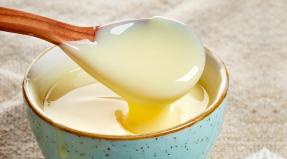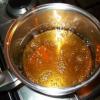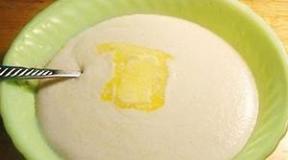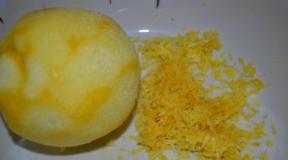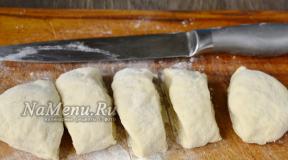Equipment for the production of mayonnaise. Maonez Technological Production Line Production Technology Mayonnaise Production Technology at factory
The food industry has always been considered a rather promising area for profit. But in order to start multiplying income, producing and implementing finished products, it is important to choose such a product that, regardless of the season, is in demand from the consumer. Here, without any doubt, we will take the mayonnaise. It is the production of mayonnaise, according to many experts, today is one of the most promising industries. Having spent so many tools, you can organize your own stable case in the field of food manufacturing.
Our business assessment:
Starting investments - from 2000,000 rubles.
Market saturation - average.
The complexity of the opening of the business is 7/10.
Mayonnaise - creamy mass prepared on the basis of vegetable and animal raw materials. This product was loved by consumers for its taste and is used everywhere to refuel hot and cold dishes.
Despite the seeming complexity, open a mini mayonnaise plant in Russia is easy. The main difficulties that will be waiting for every entrepreneur are associated with the documentary design of the workshop and bringing it to the proper form - the device of sewage and ventilation, the preparation of warehouses, maintain optimal storage modes for raw materials and a finished product. We will not forget that it is planned that the food company is planned, and therefore it will have to work on the study of regulatory documentation.
So, what should be provided for by the entrepreneur organizing his own business on the production of mayonnaise?
Maoneza manufacturing technology and raw materials used
Technological scheme of making mayonnaise
Raw materials used to obtain a finished product are publicly available in any region of our country. But to minimize costs, it is better to conclude a contract for the wholesale deliveries of all necessary components. And then it is worth choosing those suppliers that are located as close to the workshop. What ingredients will have to be purchased?
- Vegetable oil (soy, sunflower, corn, olive).
- Milk (whole, dry),
- Sugar.
- Salt.
- Vinegar.
- Soda.
- Additives.
 The list of raw materials may vary, since each particular factory uses its own unique recipe that keeps in the strictest secrecy. And because if the entrepreneur does not know how mayonnaise do, he must be hired (even before launching the plant) to the staff of the experimental technologist, which would calculate the ratio of all components. Success on the market will largely depend on this, because the more tastier the product, the greatest demand it will use.
The list of raw materials may vary, since each particular factory uses its own unique recipe that keeps in the strictest secrecy. And because if the entrepreneur does not know how mayonnaise do, he must be hired (even before launching the plant) to the staff of the experimental technologist, which would calculate the ratio of all components. Success on the market will largely depend on this, because the more tastier the product, the greatest demand it will use.
In general, the production of mayonnaise can be described as:
- Preparation for the processing of individual components of the formulation.
- Obtaining mayonnaise paste when all raw materials are mixed to homogeneous state.
- Thermal processing of the resulting paste at a temperature of 53-55 ° C.
- Cooling mayonnaise to a temperature of 15-20 ° C.
- Homogenization of the finished mayonnaise until the perfectly balanced mass is obtained.
- Packing and packaging of the product.
Methods for producing the finished product may vary, but literally each process passing during its manufacture must be strictly monitored. After all, even the slightest deviations from the specified parameters can lead to low-quality products.
Equipment for the production of mayonnaise

Mayonnaise Production Line
The next thing to do the entrepreneur is to buy equipment for the production of mayonnaise. The choice of technical equipment Suppliers offer quite wide. Differences in the device lines are insignificant, therefore, choosing devices, it is better to focus on some other parameters:
- price,
- power,
- the degree of automation of the process
- method of packing.
The standard vacuum line of making mayonnaise consists of the following equipment units:
- Intermediate and finite containers for mixing raw materials and storing the finished product before packing.
- Pasteurizer.
- Homogenizer.
- Filling machine.
At the same time, automation and lines are varying, the market price of equipment for the production of mayonnaise varies. For example, a line of up to 1000 kg / day can be purchased for 700,000 rubles. But more powerful equipment (up to 2500 kg / day) will cost an entrepreneur not cheaper than 1500,000 rubles.
In the business plan, in addition to spending on the main equipment, it is also worth including the cost of auxiliary aggregates. In this case, large investments will require cameras for storing some types of raw materials and a finished product. This is at least a minimum of 200,000 rubles.
Ready Product Sales Options
The mayonnaise production workshop will only start making a profit when all manufactured products will come true to customers. And now the search for interested consumers will take away at first a lot of time in the entrepreneur.
Competition in this niche is small, but this does not make it easier to find buyers. Large networks of hypermarkets are reluctant to come to contact with small business representatives, and sales of small wholesale will not provide large income.
It is important to offer customers a large range of products. And the point here is not even in the recipe of the Maonez himself, but in that container, in which he will be fascified. Plastic and glass jars, packages, disposable packages - you can use everything.
To attract customers, the technological scheme for the production of mayonnaise should be not only thought out, but also a clearly planned marketing campaign. So, the designer services for the development of attractive packaging also add to the starting costs. As for advertising, small and medium-sized businesses are unlikely to spend money on large-scale advertising campaigns, since the attention of customers here is riveted to the products of large brands - with them until competing does not make any sense. The main rate at first we make on the quality of finished products.
How profitable business on making mayonnaise?
It has already been proven in practice that making mayonnaise can bring consistently high profits. And if you find the required starting capital on the organization of business, then the workshop will be able to recoup all costs in a short time. And attachments, even at minimal attacks, will be impressive - at least 2000,000 rubles. And the main costs of expenses will come to the commissioning of the acquired line, prepare for the work of the premises and the development of packaging design.
Attachments will be slightly more if you provide our own fleet at the factory to deliver finished products to customers.
Acquired on the available amount of mayonnaise production will be made by no more than 1000 kg of finished product per day. At the same time, the wholesale price for the mayonnaise of the budget brand fluctuates in the area of \u200b\u200b50 rubles / kg. And knowing average exhaust volumes, you can determine the monthly sales revenue - it will be at least 900,000 rubles. Taking into account variables, spending (rent, transport, taxes, communication, s / n employees), net profit will be ≈100,000 rubles.
For a detailed study of various quality indicators of the object under study, it is necessary to consider its production technology.
Mayonnaise is an oil emulsion - water, where the dispersion medium is water, and the dispersed phase is oil.
Raw materials for the production of olive mayonnaise are plant refined deodorized oils, milk powder, egg powder, sugar, salt, mustard and other food and taste additives.
In the manufacture of mayonnaise, it is mainly used liquid sunflower and olive oil, less often soy and bright cotton.
Dry milk and egg powder, vegetable phospholipids are used as emulsifiers. Dry milk is used simultaneously both as a structural agent, milk proteins in the presence of moisture are capable of swelling, and this helps moisture and provides a structuring effect on all components included in mayonnaise.
The mustard powder is a flavored supplement, and proteins contained in it also provide emulsifying and structure formation.
Salt gives the taste of the product and has a preservative action; Food soda supports a certain pH, due to which the process of swelling of milk proteins is improved.
Sugar is a flavored additive, acetic acid performs the same function and, in addition, increases the bactericidal properties of mayonnaise. Phosphate corn starch (starch and phosphoric acid ester) is used as a structural agent and a stabilizer of low-concentrated mayonnaise.
Water in the production of mayonnaise is necessary for dissolving the salt and sugar, for dissolving and swelling of milk proteins and other recipe components.
Egg powder is used in powder form, it should not have extraneous smell and taste. The mustard powder should be dry, possess the sharp smell of allil oil and do not darken. In the mustard paste should not be felt the sharpness and the bitterness not characteristic of the fresh mustard, delights.
The production of olive mayonnaise can be divided into the following stages and operations:
Preparation of dry and liquid components;
Dosing of components and preparation of phases;
Phase dosing;
Phase temperature processing;
Preliminary emulsification;
Getting ready mayonnaise;
Mayonnaise facility;
Boxing;
Transportation to the warehouse and storage of finished products.
The olive mayonnaise production line begins with a complex of equipment for the preparation of dry and liquid components, including containers and pumps. Next, in the course of the technological process, complexes for the preparation and dosing of the phases containing counters, heat exchangers, capacity, pumps and homogenizers are provided.
The following complex is designed for temperature processing and pre-emulsification, which includes heat exchangers, pumps - dispensers and emulsifiers.
The master is a complex of equipment to obtain a finished mayonnaise, which contains containers and pumps-dispensers.
The final complex includes equipment for the facility of mayonnaise and styling it in the boxes.
The Capacity E1 includes refined deodorized vegetable oil. Sinking dry components (egg powder, dry skimmed milk, mustard powder, sugar sand, salt, food soda) weighed on scales in accordance with the distribution of the recipe set of phases and are sent to the E3 and E container; For the preparation of phases 1 and 3.
Phase 1 - Egg powder suspension in vegetable oil - egg powder is mixed with vegetable oil supplied through the volume counter, at a temperature of 65 ± 2 C. Phase 2 - 10% solution of acetic acid, which is prepared by mixing 80% acetic acid and water. Phase 3 - vegetable oil, dry skimmed milk, high-purity powder and soda - all components are mixed at 20 ± 5 s and the rotational speed of the stirrer 0.83 s -1. After the formation of the first-mogue suspension, water, sugar sand and salt are served.
For the preparation of phase 1 from the E1 tank of the pump H1 through the volume counter of CO1 and the TP1 heat exchanger, the vegetative oil (65 ± 2) C and the egg powder is loaded, and the phase pasteurization is stirred and the phase pasteurization occurs. From which the pump-dispenser ND1 is sent to cooling to (15 ± 5) ° C to the cooling cylinder CT1 heat exchanger and further in the Emulsor combinator (homogenizer) CE1.
In the E4 capacity for the preparation of the phase 3 of the E1 capacity of the N1 pump through the volume meter, vegetable oil is pumped and pre-weighed dry skimmed milk, mustard powder and soda. Then the water is supplied to the remaining dry components (sugar sand and salt). After stirring, the phase 3 is sent to the EP4 distribution capacity, from which the pump-dispenser ND1 is on pasteurization to the heating cylinder of the KT1 heat exchanger combinator. Pasteurization is performed at (82 ± 2) ° C with shutter speed at this temperature for 6 minutes. Then, in the second cooling cylinder, the CT1 heat exchanger combinator 3 is cooled to (155) ° C.
The pressure at the outlet of the cooling cylinders should be 0.15 ... 0.20 MPa. From the heat exchanger combinator, the phase 3 is sent to the CE1 emulsifier combinator.
Phase 2 is a 10% solution of acetic acid - prepared in the E2 tank.
Vegetable oil (phase 2) through the TP1 plate heat exchanger and the distribution capacity of the EP1 pump-dispenser ND1 is supplied to the CE1 emulsor combinator. The pre-emulsion formed in it is directed to the rotary homogenizer G1, which is mixed with a 10% acetic acid solution (phase 2) supplied by the pump-dispenser ND1 from the EP3 tank. The mayonnaise emulsion is processed in a rotary homogenizer G1 by pushing through the gap between the stator and the rotor (from 0.1 to 1.5 mm) at the rotational speed of the rotor shaft 13.3 ... 15.0 s -1.
Ready mayonnaise after a homogenizer G1 enters the E5 capacity, from where the NV1 screw pump is supplied to the MF1 phasing machine, which spills the mayonnaise into the PVC cups with a capacity of 250 g. From the packing machine, cups with mayonnaise are sent to weighing on scales B1. After weighing, the cups that satisfy the requirements of the standard are sent to the MU1 machine for laying in drawers from corrugated cardboard. The machine places 4 cups from above in 3 rows and 3 layers (36 pcs.) To each box. Owned drawers are directed to a warehouse where finished products are stored before departure to the consumer at a temperature of 0 ... 18 ° C and relative air humidity not more than 76%. Cups with mayonnaise, who did not pass the weight control in the packing machine.
The block diagram of the Maonez production process is presented in Figure 1.
Figure1 - Maoneza production flowchart
The production of mayonnaise is still not fully studied because there are many technologies for the preparation of the mixture, as the base for the future product. Everything comes from ancient times, when it was used extraordinary ways to create this "delicacy" to give food piquancy and unusualness.
The history of the production of mayonnaise and sauces
Food industry historians offer four possible theories of the origin of mayonnaise. The most popular story is dated June 28, 1756, when French captured Port Maison on the Spanish Island of Menorca. When preparing the holiday of Victory, the Chef Duke was forced to replace olive oil on cream in sauce. Suddenly satisfied with the result, the chef dubbed the final sauce "Mayonnaise" in honor of the victory.
Caramea, French writer and author Cuisinier Parisien: Trarte des entries frides believed that this word was obtained from the French verb "Manier", which means mix. Another Food Expert, Prosper Montane, argued that the origin lies in the old French Word "Moyeu", which means egg yolk.
Third insist that the creamy sauce was its own development of the city of Bayonna in the south-west of France. Thus, what was originally called "mayonnaise", later was modified for mayonnaise.
Regardless of its origin, mayonnaise quickly gained popularity, so it is not surprising its appearance in all European cuisine. In the early 1900s, the German immigrant named Richard Hellmann opened a delicacy in New York. Salads who made his wife with were particularly popular. When customers began to ask if they can buy mayonnaise himself, Hellmans decided to produce it in bulk and sell by weight in small wooden vessels for measuring oil.
In the end, Hellmans began to sort her mayonnaise into glass jars. In 1913, they built their first mayonnaise plant. Company from California Best Foods Inc. also enjoyed the success of his version of mayonnaise. In 1932, she acquired the brand "Hellman" and continued the production of both versions of the sauce.
The production of which was focused on the manufacture of lettuce gas stations, was developed by the National Dairy Products in 1933 and is presented at the World War Event in Chicago. Ultimately, the product has become famous as Kraft Miracle Whip Salad Dressing.
Maoneza production technology - features of each culture
To create mayonnaise, you only need two steps to get finished products.
Creating an emulsion:
- To maintain the correct emulsification, the continuous mixing system is used. Emulsion (known technically, as a colloid) occurs when the mixing of two liquids, in this case, vinegar and oil, leads to the fact that one of them forms small drops that are dispersed throughout the other liquid.
- A mixture of vinegar and oil is continuously moved through a row of pumps that mix components. These devices have a cavity or set of cavities with rotating impellers. The adjustable pump action causes cavities to fill and empty. The working wheels move the mixed liquid from one cavity to another.
It turns out a single consistency, which is so important for this type of product. Next, the various components are added, which is a method of diversity of the base mixture.

Adding ingredients:
- Pre-measured ingredients are fed into pipelines through holes in the side parts of the pumps or from pressure sleeves.
- Mayonnaise moves through the pumping system to the bottling station. Pre-sterilized banks are moving along the conveyor belt and pre-measured quantities of mayonnaise are placed in them. They are sealed with metal screw clamps. At the same time, not sealed in vacuo.
Such mayonnaise is used by almost 80% by enterprises and factories. The standard scheme has not changed for a long time until the species appeared with additive sauces.
Raw materials for creating sauces and mayonnaise
Mayonnaise is an emulsion "oil-in-water", which can contain up to 80% oil. Thickeners, such as starch, are used in low fat products to replace the natural viscosity and the bulk effect of oil, as well as to improve the sensation in the mouth and ensuring the formation of a stable emulsion.
You can add spices and other natural seasonings, with the exception of turmeric and saffron. They gave mayonnaise a yellow tint that did not like the consumers, so the technological line of the Mayonnaise production with them existed for long.
Also use vinegar, which is distilled off from distilled alcohol, lemon or lime juice (diluted with water). Soybean oil is the most common type of ingredient used in the production of mayonnaise.
Large-scale production, usually, is carried out using a specially designed installation. This process is often automated and is under vacuum. For research and development, experimental small-scale production are used, typical of "ready-to-use" market: manufacturers of sandwiches, catering enterprises and other small companies. For them, mayonnaise should be produced in such a way as to ensure an increase in their sales, but at the same time experimenting with the composition components.

Some typical recipes would be as follows:
- At the first stage of production, an egg that can be used in a liquid or powdered form is dispersed in water. It acts as an emulsifier.
- Then add residual ingredients of the continuous phase and stirred to dispersion and hydration.
- The oil is added so quickly so that the continuous mixing phase immediately lifted it. This leads to a sharp increase in the viscosity of the product in the formation of an emulsion.
Problem:
The "continuous phase ingredients" constitute only a small proportion of the total composition, but they perform vital functions. Mixing equipment should be able to disperse and moisturize them properly at a relatively low volume of fluid. If the egg and other emulsifiers are not properly dispersed and hydrated, the emulsion can be collapsed at the oil adding stage.
Hydration of stabilizers and thickeners is one of the most complex mixing operations. It is possible to mix ingredients for a long time for complete hydration.
Due to the high proportion of oil in the recipe, the emulsion can break if it is not added to the continuous phase correctly. It is very difficult to control when the process is performed manually.

Drops of the oil phase should be reduced to minimal size to maximize the oil surface area in the continuous stage of the Mayonez production to ensure a stable consistency of the emulsion. It is impossible to get without special equipment.
Aeration must be minimized or eliminated to ensure the maximum life of the product.
Equipment for creating mayonnaise
To achieve the desired result, you need to choose optimal equipment to create mayonnaise. The devices operate on the following principle:
- Water is recycled from the vessel through the system using a specially designed in-line mixer. Or the liquid) is added to the vessel and is quickly wetted and dispersed in a stream with high fluid velocity.
- The remaining ingredients in the aqueous phase are added to the vessel. Recycling continues until the ingredients are completely dispersed and hydrated.
- The oil supply valve opens, and it flows from the bunker to the aqueous phase with a controlled speed. The ingredients of the aqueous and oil phase come directly into the lap of the mixer, where they are subjected to intense stirring. This process finely distributes oil in the aqueous phase, immediately forming an emulsion. Vinegar or lemon juice is added with the last portion of the oil.
- The recycling of the product continues to provide a homogeneous consistency as viscosity increases. After a short period, the process is completed, and the finished product is discharged.

The method is ideal for small batches intended for immediate use. Aeration is minimized, the system practically eliminates the operator's error. The yield of raw materials is maximized, since the thickeners are fully hydrated, and other ingredients are correctly dispersed. Mass production of mayonnaise occurs somewhat differently. The process is suitable for the manufacture of more than 1000 kg of products per hour:
- Measuring pumps at the same time add various ingredients to the tank in the required proportions.
- The mixture is pumped through the built-in mixer, and mayonnaise is obtained only through one compartment, and, all ready immediately, and then pumped into the buffer tank and prepare for the package.
Equipment for the production of mayonnaise in mass quantities should be installed, according to adopted quality standards, so that the products can be used and testing.
Quality control of finished products
All raw materials checks for freshness when it enters the recycling plant. Periodically checked and stored materials. Maoneza samples are taken and checked for a taste during the production process.
Diversity of mayonnaise sauces
There are many species of mayonnaise, including light and low-fat. This health favorable seasoning can be part of a well-balanced diet that satisfies any dietary needs. Mayonnaise is made of clean oils, such as soy and rape. They are a natural source of alpha-linolenic acid, necessary omega-3 fatty acid. In addition to important bold acids, these oils are also the main source of our daily consumption of vitamin E.

Commercial mayonnaise is also one of the safest products. Salad refills contain pasteurized eggs that have been thermal processing to destroy harmful bacteria and ensure the safety of the product, so you can be sure of it. On the basis of mayonnaise create Tatar, sharp, mustard sauces. Since the production of mayonnaise is associated with the use of basic principles, they can be complemented. Diversify the taste, not a consistency or proportion, you can with the help of seasonings.
Russian plants - what do they differ?
The production of mayonnaise in Russia is somewhat different from foreign technologies and equipment. So many technologists apply basic recipes, creating only "shades" of fatty and acid compositions.
To replace fat from egg yolk, add modified food starch. So that low-fat mayonnaise maintains the creamy texture and the density of this mayonnaise, starchs from corn or agar product (extraction of marine algae) are used. In Moscow, the production of mayonnaise is engaged in high-level technology. However, the recipe is standard, not changing years. The Togrus trademark does not change the traditions and century-old quality standards.
Sometimes, according to recipes, a salt is added to enhance fragrance. This amount is approximately 1/16 teaspoon salt on the mayonnaise tablespoon. Preservatives are added to increase the shelf life, such as calcium diodium salt. But the production of mayonnaise in Noginsk was relatively recently formed, but the plant already has many awards for the honorary title "Decent Sample".
The recipe for the Dutch sauce on the basis of mayonnaise
It will take a blender for mixing products.
- Add a double amount of yasks (so that the blender blades are covered with them).
- Add 2 h. Salt.
- Melt the oil in a small saucepan on medium fire. As soon as it begins to separate and still bubbles, pour a bit into a blender with a motor running.
- Add some more oil, the emulsion should "issue" changes in sound when the blender engine is running.
- Continue slowly pour oil without adding solid particles of milk.
- Season to taste with lemon juice, salt and pepper.
Some mayonnaise enterprises have implemented such a recipe for some sauces. You can diversify them with spices and combinations of ingredients in the ratio of proportions.
Recipe "Tartara"

There are recipes "Tartara" based on mayonnaise. It is done simply, given that the basis is ready:
- Mayonnaise - 300 g
- Sour cream - 200 g
- Marinated cucumber - 1 piece.
Mix the products before the formation of monotonous consistency. Add garlic and greens to taste. Before serving on the table, bind lemon juice.
Benefit
Business for the production of mayonnaise is a fairly profitable business. The basis for such enrichment was created by Africans: they produce sauce in simple banks without inscriptions and brands using a cheap recipe and available raw materials. Thanks to such factors, many businessmen can enlist the product and create their own sale business. If we talk about the establishment of production, then you should start with small parties, because for continuous sales of 1000 kg you need to find sales points. Popularity is gaining mayonnaise without eggs - vegetarians and people who do not tolerate this product will be the main consumers.
Specific requirements are presented to machinery for the production of mayonnaise. Since the finished product does not undergo complete heat treatment, the equipment on which it is manufactured (from the stage of preparation of raw materials to the packaging process of the packaged product) must be bacteriologically clean.
For this, in addition to compliance with the hygienic regime, the equipment must meet the following requirements:
- be protected (sealing) from microflora from entering the external environment;
- do not have congestion zones in which spontaneous reproduction of bacteria may occur;
- easy to understand separate nodes for careful washing and disinfection;
- manufactured from high quality materials (with permissible purity of the processing of internal surfaces up to 0.1 μm);
- have a knot of an automatic washing.
An important meaning is equipped with the equipment for the production of mayonnaise by the deaeration unit, which makes it possible to increase product storage time, avoid oxidative damage.
In modern requirements for technological equipment, great importance is given to the full automation of production.
At the same time, weighing ingredients and raw materials are associated with the technological chain, the measurement of components in accordance with the recipe, mix them to the desired quality, control and automatic registering of the entire course of the product production process.
It is desirable that the cleaning and disinfection of the equipment is carried out by the closed cycle solutions (without the need to dismantle the equipment) - CIP (Cleaning in Place). For this, it is necessary to comply with the following requirements:
- valves must prevent the contact of the detergent solution and products;
- all surfaces in contact with the product must be available for detergent solution (in order to achieve full cleaning);
- it is necessary to exclude the possibility of corrosion of materials from which the equipment is performed.
Types of equipment
Depending on the various production schemes, the equipment for the release of mayonnaise is divided into high-performance lines of continuous or semi-continuous action, in which various stages of the process are carried out in different devices located in series and small periodic aggregates for all operations in one container, the performance of which is changed in wide limits (from 30 to 6000 l / h).
Lines of continuous production of mayonnaise
The lines of the continuous and semi-continuous production of mayonnaise have their advantages and disadvantages. The benefits include:
- high performance,
- the possibility of full automation,
- guarantee of constant product quality,
- the possibility of easy replacement of outdated or defective modules.
The disadvantages of continuous lines are:
- the need for large production areas;
- significant material intensity;
- high consumption of detergents;
- increased product loss when conducting sanitary and hygienic measures.
According to continuous and semi-continuous technologies, automated high-performance lines "Joinson" are operating (up to 1 t / h), Lines of companies "Gilder Corp.", "Cherry Barrell", "Holsum Food Co", "Stork Salatomatic", "Schroeder".
The technological scheme for the production of mayonnaise and salad seasoning on the Johnson line is shown in Figure 1.
1 - bunker for egg powder; 2 - bunker for dry components; 3 - oil tank; 4, 13 - water and vinegar tanks; 5 - Deaeer; 6, 15, 23 - pumps; 7, 10 - dispense pumps; 8, 9 - woven; 11 - the spreading tank of the woven; 12 - bunker for starch; 14 - the cooking tank of the starch suspension; 16 - pot of finished products; 17 - the casting machine; 18 - Open machine; 19 - homogenizer; 20 - feeding tank of the homogenizer; 21 - sanitary marriage tank; 22 - filter; 24 - mixer
Figure 1 - Technological scheme for the production of mayonnaise and salad seasonings on the line "Johnson"
Periodic equipment
The advantages of periodic lines are compactness, efficiency, a wide range of performance. However, it should be said that periodic lines work efficiently only in the presence of full automation.
In the production of mayonnaise, the main technological line devices are homogenizers (or dispersants), which should provide homogeneous fine-dispersed emulsions with a given particle size. High-speed stirrers, high-pressure homogenizers, colloid mills, rotary-stator systems, homogenizing devices, which are combined with vacuuming the product in a hermetically closed apparatus and pumping the product "to return" at high speed, which makes it possible to achieve the desired degree of dispersion finished product.
Imagine equipment for the production of mayonnaise of some leading German firms.
"BUT. Stefan and Sons GmbH & Co. "manufactures modern machines and installations for use in many areas of the food industry. For the production of mayonnaisms, universal UMM / SK type machines are of interest, a universal Vacutter-mixer type VM / MC and a Homogenizer "Stefan MSN MSN 10/2". These periodic machines can work both in manual and in semi-automatic and automatic process control modes according to a specified program.
Stefan UMM / SK aggregate has a rational design suitable for integrating in already available equipment, it is easy to maintain and washing, multivariate, allows you to get the stable quality of the product produced. The machine is a sealed container equipped with a double jacket, into which the elongated shaft is omitted, which serves for the nozzle of the working tool - sharp knives or mixing blades. Included, there is also a vehicle blade for removing particularly viscous materials from the walls and the directions of them to the center of the tank. Simultaneously with the mechanical in the machine there may be thermal processes: heating can be carried out both direct steam supply and through a shirt. All processes can pass under vacuum conditions. A minivariant is also produced for small batches of experienced products in laboratories - Umm / SK 5.
Technical data of these machines are shown in Table 1.

Installation "Stefan Wakutm" is designed for the production of sauces, mayonnaise, food emulsions, as well as soup-purees, various meat and fish products. The basis of the modular system of the vacuerma (Figure 2) is a diagonally installed hermetic working capacity with a attached gearbox, on which a stirrer with a scraper is fixed. The drive shaft is compacted by the capacitance side by contact sealing ring of a two-way action, which under sanitation measures steam. The circulation pump serves to uniformly supplying the product through the homogenizer and the recycling system back into the working capacity. At the end of the emulsification and homogenization cycle, additional components are submitted to the sauce and in the final stage there is a homogeneous mixing process. The product circulation can be carried out by choice via a homogenizer or by passing it. The circulation pump is simultaneously the discharge pump.
 1 - Stefan Wakutm; 2 - loading hole DN 200; 3 - viewing window DN 125; 4 - vacuum connection; 5 - discharge fitting; 6 - discharge pump; 7 - Stefan Microcut MSN; 8 - Dosing funnel - dry substances; 9 - dosing funnel - liquids; 10 - Control cabinet
1 - Stefan Wakutm; 2 - loading hole DN 200; 3 - viewing window DN 125; 4 - vacuum connection; 5 - discharge fitting; 6 - discharge pump; 7 - Stefan Microcut MSN; 8 - Dosing funnel - dry substances; 9 - dosing funnel - liquids; 10 - Control cabinet Figure 2 - Module "Stefan Wakutm"
The modular vacuer systems are equipped with a shirt for indirect heating and cooling the contents of the container. However, it is also provided for the supply of acute steam and inert gases for rapid heating and cooling in gentle mode.
The vacuum installation system consists of a vacuum pump and an adjustment unit operating in automatically specified mode. The main working element of the installation is a Stefan homogenizer with a rotary-stator system, which can be equipped with various rings with a gap from 0.1 to 3 mm and thereby regulate the process of homogenization and emulsification.
TECHNICAL DATE INSTALLATIONS "STEFAN VACUTERM" is shown in Table 2.

Homogenizers "Stefan Microcut" for energizing and emulsifying soups, sauces, desserts with performance (depending on the degree of grinding) from 3000 to 6000 l / h as the main working body also have a disintegrator.
Fryma manufactures equipment for the production of food emulsions, mashed potatoes, jams and confitures, pasty products.
For the production of mayonnaise and salad sauces, the company has developed MZM / VK "DELMIX" (Figure 3).
 Figure 3 - Processing
Figure 3 - Processing installation MZM / VK "DELMIX"
The product passes the emulsifying head and through the recycling pipe is returned to the container to achieve the necessary degree of emulsification. The emulsifying head consists of a rotor and a stator, the gear of which is selected with the desired degree of product dispersion. The DELMIX settings are produced 10 modifications, with a capacity of 7 to 3000 liters.
The company "KORUMA" Since 1970, manufacturing installations for obtaining dispersed and homogenized foods. For the production of mayonnaise emulsions, DISHO installations are offered with a capacity capacity from 85 to 1300 liters (Table 3). Installations are equipped with a rotor-stator homogenizer, recirculation and evacuation systems.

The mixing of the product is carried out in horizontal and vertical directions. Control process automatic in accordance with the program.
Equipment of domestic production
Russian manufacturers also produce machines for making mayonnaise products that are distinguished by significant simplicity in placement and operation.
For example, Mini Installation "Mais" manufactured by SPKF "Stroyveest" (Dzerzhinsk Nizhny Novgorod Region) is intended for the production of food emulsions (mayonnaise, creams, pastes, jams, sauces, confitures and other food mixtures of various recipes) at catering establishments, dairy and oil and fat plants, small and medium-sized businesses.
The principle of operation of the installation is based on the sequential two-stage acquisition of mayonnaise: first dispersing all mayonnaise components except the oil, then slow oil supply and homogenization of the mixture.

The installation can be recycled by a dispenser and an electric sealing machine with shift heads.
Installation for the preparation of mayonnaise FLITM is equipped with a homogenizer of the original design of the Bulgarian production with a capacity of 1500 l / h. Installation performance up to 3000 kg / shift.
IS-160 and IP-88 is-80 shredtitelis offers for the production of sauces and mayonnais the company "Consita". The installation is equipped with a stirrer, a shirt, a vacuum chamber, an acute steam injection collector, as well as automatic control.
The company "Elf-4m" produces a module mayonnaise IPKS-056 with a capacity of 3000 kg / day, equipped with a rotor-fuzzy installation of RPA-1.5-5, as well as the mining of mayonnaise based on this module.
In the installation for the production of mayonnaise Ma-0.5, proposed by OJSC TverAgropodmash, a capacity of 500 l / h homogenizer serves a colloid mill of an original design that consumes three times less electricity compared to piston homogenizers.
Equipment sets for the production of mayonnaise with a capacity of 300, 500, 800 and 1000 kg / shift, in which dispersion and homogenization are provided with a rotary pulsation apparatus, offers Agro-3 JSC. The equipment ensures the pasteurization of raw materials and the finished mayonnaise. The duration of the cycle does not exceed 2.5-3 hours.
Installation for the production of mayonnaise offered by Enomash enterprise is intended for the preparation and packaging of mayonnaise of various varieties in polystyrene cups and glass jars. The kit includes a boss mixer, a rotor-fuzzy apparatus, a pump, a set of locking equipment and a packaging semi-automatic.
Manufacturers of equipment of Russia and the CIS countries offer customers as sets of equipment for the production of mayonnaise and individual homogenizers already known brands, mainly designed for the dairy industry. For example, the company "Agro-3" offers homogenizers of the OGA, Odessa Mechanical Plant - Homogenizers K5-OG2A and A1-OG2M, Flytm company - Homogenizers of Bulgarian production MDX-401, Stupinsky Factory of the Moscow Region - RPA Homogenizers.
Packaging mayonnaise to avoid worsening quality and reduce storage time spend immediately after developing. For this, various packaging equipment is used, depending on the container used, the choice of which, in turn, is dictated by the peculiarities of the technological process, the calorie content of the product and the storage periods.
The range of currently used containers and packaging is very large: from the flask with a capacity of 18 and 25 kg to plastic bags weighing 150 g. It is widely used both traditional glass double-gram "mayonnaise" jars and fiberglass with a "twist-off". Mayonnaise package in plastic cups and buckets, tubes, plastic jars with various lids, polyethylene sachets of various capacity, Pure-Pak packaging, etc. Materials from which these types of containers are manufactured, have high chemical resistance to mayonnaise and its components, and Hygienic indicators do not exceed existing sanitary standards.
Equipment for the packaging of mayonnaise products into polyethylene, polypropylene, laminated, glass container with various types of capping produces many and foreign and domestic firms.
"Istok" offers automatic lines "alta-4" for packing and capping homogeneous viscous products into polystyrene cups with a lid of aluminum foil with a thermolam, a capacity of 100 to 500 ml (with a capacity of 900-1400 packs per hour).
Auto machines AU50F (g) - vertical packaging in polypropylene bags weighing from 0.1 to 1.0 kg, 35 packages with a minute, comes with Flyt-M company.
Mayonnaise is one of the most common food industry products and one of the most popular mass consumption products. His consumption in Russia reaches 3 kg per person per year, and this figure is constantly growing. The production of mayonnaise is considered one of the most cost-effective. In addition, it is characterized by simple technology, which allows you to establish a production process for a short term in 1 - 2 months.
To establish our own production of mayonnaise, it is necessary: \u200b\u200bfirst, a room that meets sanitary and hygienic requirements, second, equipment, third, an experienced technologist.
Before purchasing equipment, it is necessary to determine the volume of production. And only after that proceed to the choice of a set of equipment. The sets of kits are very similar, the differences are in the design of the homogenizer - units producing crushing of the mass of oil on microscopic drops. However, these differences are not fundamental. The main factors affecting the choice are the cost of equipment and the degree of automation of the technological process.
The choice of equipment for the packaging depends directly from the packing method, which will be used in production. The easiest way is to packing plastic containers, the shelf life when using this type of packaging is minimal. But the equipment used for this type of packing is the least expensive of all kinds. Packing in glass jars is the most hygienic, gives the maximum shelf life. Reparatively inexpensive equipment. However, this is the most time-consuming method of packing. The most expensive equipment is used for packaging mayonnaise into polymer disposable packages, this is the least laborious way. In addition, in this case, minimal costs of storage and transportation of the product are minimal.
The table shows the important technical indicators of the sets based on IPKS-056 mini
The raw materials needed for the production of mayonnaise includes: plant vegetable (sunflower, soy, corn, cotton), egg powder, cow's milk solid dry and dry skimmed, starch corn and potato, sand sugar, salt, acetic acid, drinking soda, water. The quality of the finished product will depend on the quality of raw materials, as well as the recipe. Development of recipes - technologists are engaged, branded recipes are commercial secrets. Therefore, the quality of the product depends on the qualification of the technologist, and therefore its success in the market.
Below is a table of the value of the main components of the raw materials (without VAT, at St.999 in the Moscow region) (approx. Website: prices can be substituted today - the main principle of expectations)
The process of manufacturing mayonnaise consists of four main stages:
. Preparation of prescription components
Preparation of mayonnaise paste
Preparation of mayonnaise emulsion
Packing, Packaging, Marking
Cooking mustard.
24 hours before the start of the Maonez production, the required amount of mustard powder is placed in an enameled or stainless steel dishes and poured with water with a temperature of 80-100 ° C in a ratio of 1: 2. The mixture is well stitching to a homogeneous consistency with the burning of the upper layer. A water with a temperature of 100 o with a height of 4-6 cm is carefully poured onto a flat surface of the mixture with a height of 4-6 cm. The capacity is tightly closed with a lid and left alone for a day. Before use, the upper layer of water is carefully merged.
Preparation of the solution of egg powder.
In the food capacity, the egg powder is dispersed in warm water with a temperature of 40-50 o C in a ratio of 1: 1, then hot water is added to the mass with a temperature of 60-75 o C to obtain the ratio of the egg powder and water 1: 1.5. The composition is thoroughly mixed manually until a homogeneous mass is obtained.
Preparation of acetic salt solution.
The aluminum tank, pre-filled with the corresponding formulation by the amount of salt, is poured 9% table vinegar vinegar and is brought by diluting with water.
Preparation of mayonnaise paste
Dry components from the filled measuring containers are poured into the emulsant mixer and are flooded with boiled water with a temperature of not lower than 30-40 o C. The mixture pasteurizes (heats up to 80-85 ° C) with thorough stirring for 30 minutes. Sugar sand is added. At the end of pasteurization, the mass is stirred and cooled to a temperature of 50-55 o C. Then the prepared amount of egg powder and mustard is introduced. The mixture is heated again (up to 60-65 ° C) and withstands 25-30 minutes with it, and then cooled to 30 o C.
Preparation of mayonnaise emulsion
In the mayonnaise paste, a vegetable oil is introduced with further stirring. After the entire dose of oil and the receipt of a homogeneous emulsion is introduced acetic salt solution and the mixture is still mixed with 15-20 minutes. At the last stage, the final homogenization of the mixture obtained is carried out using a homogeneration pump, after which the product is poured into the flasks or in the manufacture of finished products for further packaging and packaging. As we have already talked above, the packaging mayonnaise can be carried out in several ways. On small lines, polymer packaging and simple and productive metering (by volume) of the UD-2 type device are most often used and installing welding cups from polystyrene of AL-Foil USS-2.
Approximate recipes for making mayonnaise "Salad", "Provence"
About prices, cost of production, profits and payback periods
(excerpts from feasibility calculations)
The cost of products is made up of the cost of raw materials, materials, fuels, energy, fixed assets, labor resources, as well as other costs of its production and implementation.
The results of calculating the cost of 1 liter of products and its selling price are shown below.
Initial data:
work is carried out in 3 shifts (8 hours);
The salary of each worker is 1,500 rubles;
In a month 25 business days;
Product sales - 100%.
Procurement wholesale prices for raw materials and ingredients (without VAT, at St.999 in Moscow region) (approx. Website: prices can be substituted today - the main principle of expectations)
The main conclusions from the results of calculations
1. The time-readability point for all sets is the same and is about half of the month (approx.OpenBusiness: ???). This is explained by the same ratio of constant and variable costs adopted in the calculations.
2. The performance of the equipment determines the period of its payback and size of net profit. The higher the performance of the equipment, the higher the net profit and less payback period.
3. The profitability in these calculations is 10%. But its level depends on the prices for the implementation of the final product - if prices significantly exceed the cost of the final products produced, then the profitable profit will grow and accordingly increase the profitability of production.
According to the materials of the site Equipnet.ru


